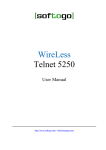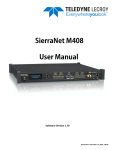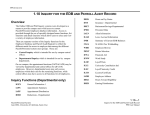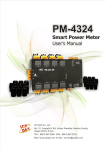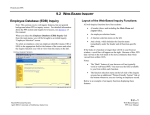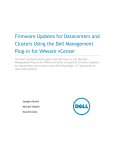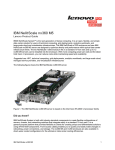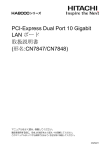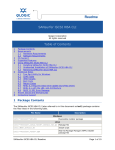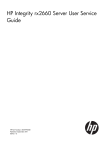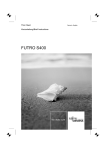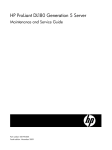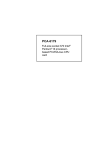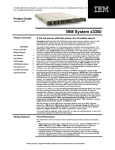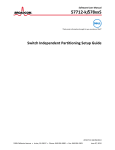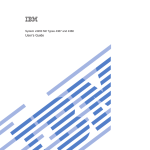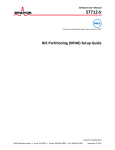Download Broadcom Comprehensive Configuration Management for HP
Transcript
Broadcom Comprehensive Configuration
Management for HP FlexFabric Adapters
User Guide
Abstract
This document is for the person who installs, administers, and troubleshoots servers and storage systems. HP assumes you are qualified in the
servicing of computer equipment and trained in recognizing hazards in products with hazardous energy levels.
Part Number: 746499-001
September 2013
Edition: 1
© Copyright 2013 Hewlett-Packard Development Company, L.P.
The information contained herein is subject to change without notice. The only warranties for HP products and services are set forth in the express
warranty statements accompanying such products and services. Nothing herein should be construed as constituting an additional warranty. HP shall
not be liable for technical or editorial errors or omissions contained herein.
Microsoft®, Windows®, and Windows Server® are U.S. registered trademarks of Microsoft Corporation.
Contents
Introduction .................................................................................................................................. 5
Overview ................................................................................................................................................. 5
CCM mode and invocation ........................................................................................................................ 5
Menu mode ................................................................................................................................. 7
CCM menus ............................................................................................................................................. 7
Device List menu........................................................................................................................................ 7
Main Menu .............................................................................................................................................. 8
Exit Configuration menu ............................................................................................................................. 9
Parameters that take effect after rebooting .................................................................................................. 10
Device Hardware Configuration menu ....................................................................................................... 10
MBA Configuration Menu ........................................................................................................................ 12
iSCSI Boot Main Menu............................................................................................................................. 13
General Parameters menu .............................................................................................................. 15
Initator Parameters menu ................................................................................................................ 16
1st Target Parameters menu ............................................................................................................ 17
2nd Target Parameters menu........................................................................................................... 18
Secondary Device Parameters menu ................................................................................................ 18
FCoE Boot Main Menu ............................................................................................................................. 20
General Parameters menu .............................................................................................................. 21
Target Information menu ................................................................................................................. 23
Target Parameters menu ................................................................................................................. 24
Scripting mode ........................................................................................................................... 25
Scripting mode overview .......................................................................................................................... 25
Operation device scope ........................................................................................................................... 26
Script file format ...................................................................................................................................... 26
Comments .................................................................................................................................... 27
Device block ................................................................................................................................. 27
Section declaration head ................................................................................................................ 27
Group declaration head ................................................................................................................. 27
Key and value ............................................................................................................................... 28
Mapping key words from menu ....................................................................................................... 28
Case sensitivity and space sensitivity ................................................................................................ 28
Hidden string or password field treatment ......................................................................................... 28
Script execution order .................................................................................................................... 29
Convert -get result for use by -set ..................................................................................................... 29
Log file................................................................................................................................................... 30
Script command example ......................................................................................................................... 30
-list operation ................................................................................................................................ 30
-get operation ............................................................................................................................... 30
-set operation ................................................................................................................................ 32
-getItemGuide operation ................................................................................................................. 33
Support and other resources ........................................................................................................ 39
Before you contact HP.............................................................................................................................. 39
HP contact information ............................................................................................................................. 39
Contents
3
Acronyms and abbreviations ........................................................................................................ 40
Documentation feedback ............................................................................................................. 42
Index ......................................................................................................................................... 43
Contents
4
Introduction
Overview
This document outlines the various menu prototypes of Broadcom CCM and provides visual representations
of each menu.
CCM mode and invocation
CCM provides menu mode and scripting mode. The modes share the same data structure and keywords.
CCM is embedded inside the option ROM of Broadcom networking devices. When you update firmware, the
option ROM CCM also updates if the firmware update includes a later version of the option ROM CCM.
The following table shows CCM invocation in three different environments.
Environments
Option ROM
Invocation
Ctrl-S/Ctrl-B
DOS
ccmcfg.exe
Windows 32-bit Windows 64-bit Linux*
ccmcfg32.exe ccmcfg64.exe
ccmcfg.bin
*Linux ccmcfg is a 32-bit application. To be able to use it on a 64-bit Linux platform, be sure you have certain 32-bit
application support modules installed. For example, on the 64-bit version of Red Hat Linux 6.0, the 32-bit version of
glibc (glibc-2-12-1.7.el6.i686.rpm) and nss-softokn-freelb
(nss-softoknfreebl-3.12.7-1.1el6.i686.rpm) RPMs need to be installed in order to install the ccmcfg. For
details and accurate information, see the Linux user manual and release notes.
Install both RPM files with one command:
->rpm -ivh glibc-2-12-1.7-el6.i686.rpm
nss-softokn-freebl-3.12.7-1.1el6.i686.rpm
Introduction
5
Press the Ctrl-S keys (default) or the Ctrl-B keys (depending on the configuration) to invoke the CCM menu in
the option ROM screen during the boot sequence.
If you have multiple Broadcom networking cards in the platform, the CCM invocation banner only appears
once during the boot sequence for all devices. The invoked CCM manages all supported devices in this
platform. If CCM versions in different devices are different, the CCM with the latest version launches. When
the first, running option ROM does not have CCM with the latest version, a message of “Newer
Configuration Software on Other Device Detected, to be Launched Later...” appears. The CCM launches
when the option ROM with the latest CCM version loads.
Introduction
6
Menu mode
CCM menus
To invoke the CCM menu, do one of the following:
•
Press the Ctrl-S or Ctrl-B keys during the boot sequence.
•
Enter the ccmcfg command in DOS or a shell environment.
The CCM menu lists all supported devices in the current platform.
Device List menu
The Device List menu describes the Broadcom devices detected in the system.
The MBA version is not directly visible for LOM devices and appears as BIOS Built-in.
Menu mode
7
Main Menu
The Main Menu describes the configuration options available for the device selected in the Device List menu.
The following configuration items appear in the menu depending on a number of factors, such as if the device
supports certain functionality, the presence of a valid license (if applicable), and the installation of the
corresponding firmware package on the device. For more detailed information, see your specific device
data sheet.
•
Device Hardware Configuration (shown under 10G device only)
•
MBA Configuration
•
iSCSI Boot Configuration
•
FCoE Boot Configuration
•
NIC Partition Configuration*
•
AFEX Configuration*
*Feature not supported by HP adapters.
Menu mode
8
Exit Configuration menu
If you made configuration changes in the submenus, the Exit Configuration menu appears when you exit the
Main Menu. CCM prompts you to save or discard configuration changes before returning to the Device List
menu.
Menu mode
9
Parameters that take effect after rebooting
If you invoke CCM from a DOS, Windows, or Linux environment instead of the option ROM, some
parameters take effect when you reboot the computer, such as the Hardware Configuration menu
parameters. When you change and save parameters in these menus, a prompt appears reminding you to
reboot the computer.
Device Hardware Configuration menu
The following table describes device hardware configuration options.
Device Hardware
Configuration parameter
Parameter option
Description
Appears when a device supports multi-functions
Multi-Function Mode*
MF
Multiple function allowed mode (only applies to
certain devices)
SF
Forced single function mode
SPIO4
DCB Protocol
NPAR
NIC partitioning multi-function mode
AFEX
VNTag multi-function mode
Enable/disable DCB protocol
Menu mode
10
Device Hardware
Configuration parameter
Parameter option
Description
Enable/disable energy efficient ethernet
Energy Efficient Ethernet*
Optimal Power and
Performance
Maximum Power
Maximum Performance
FLR Support
Enable/disable PCIE function level reset
(enabled with PCI passthrough only)
SR-IOV
Enable/disable SR-IOV
Number of VFs per PF
Number of VFs per PF in multiples of 8
Max Number of PF MSIX
Vectors
Maximum number of PF MSIX vectors
Storage Personality
Storage personality of function (applicable only
in forced single function mode on certain
devices)
iSCSI
FCoE
*Feature not supported by HP adapters.
The following image shows an example configuration with the Storage Personality parameter available.
Menu mode
11
MBA Configuration Menu
The following table shows MBA configuration options.
MBA configuration
parameter
Description
Option ROM*
Enable/disable option ROM for a running device
Boot Protocol
Specify the boot protocol of the device
Boot Strap Type
Specify the boot strap type of the device
Hide Setup Prompt
Enable/disable MBA banner display during system boot
Setup Key Stroke
Specify key strokes to invoke CCM menu during system boot
Banner Message
Timeout
Specify the seconds of MBA banner display time
Link Speed
Specify the MBA link speed of the device
Pre-boot Wake On LAN Enable/disable the device pre-boot wake on LAN
Enable/disable VLAN mode
VLAN Mode
VLAN ID
Specify VLAN ID (valid when VLAN mode is enabled)
Boot Retry Count
Specify MBA boot retry times when boot fails before returning to BIOS (not supported
on NX1 devices)
Blink LEDs
LED on NIC card blinks to identify mapping between the menu entry with the physical
card location (not supported on 10G card)
*Feature not supported by HP adapters.
Menu mode
12
iSCSI Boot Main Menu
The iSCSI Boot Main Menu describes the iSCSI Boot configuration options.
Menu mode
13
For BCV-based iSCSI ROM, the Secondary Device Parameters menu entry is not applicable and therefore
hidden.
Menu mode
14
General Parameters menu
The General Parameters menu describes the iSCSI boot general parameters available for configuration.
The following table describes iSCSI boot general parameter configuration options.
iSCSI boot parameter Description
TCP/IP Parameters via
DHCP
Enable/disable iSCSI boot initiator to acquire IP address via DHCP
iSCSI Parameters via
DHCP
Enable/disable iSCSI boot initiator to acquire iSCSI target parameters via DHCP
CHAP Authentication
Enable/disable CHAP authentication
Boot to iSCSI target*
Enable/disable device to boot from iSCSI target after successful iSCSI login to iSCSI
target (not applicable for BCV-based iSCSI ROM)
DHCP Vendor ID
Specify DHCP vendor ID
Link Up Delay Time
Specify seconds that iSCSI boot initiator delays before attempting to connect to the
target
Use TCP Timestamp
Enable/disable TCP timestamp
Target as First HDD*
Specify the iSCSI target drive targeted as first HDD in system (not applicable for
BCV-based iSCSI ROM)
LUN Busy Retry Count
Specify number of retry attempts if iSCSI target reports a LUN busy condition
IP Version
Specify IP version
Enable/disable HBA boot mode (only visible for devices with a valid offload license)
HBA Boot Mode
*Feature not supported by HP adapters.
Menu mode
15
For BCV-based iSCSI ROM, the Boot To Target and Target as First HDD parameters are not applicable and
are hidden.
Initator Parameters menu
The following table describes iSCSI boot initiator parameter configuration options.
iSCSI boot initiator
parameter
Description
IP Address
iSCSI boot initiator IP address
Subnet Mask
Subnet mask of iSCSI boot initiator
Default Gateway
Default gateway of iSCSI boot initiator
Primary DNS
Primary DNS of iSCSI boot initiator
Secondary DNS
Secondary DNS of iSCSI boot initiator
iSCSI Name
IQN name of iSCSI boot initiator
CHAP ID
iSCSI boot initiator CHAP ID (valid when CHAP authentication is enabled)
CHAP Secret
iSCSI boot initiator CHAP secret (valid when CHAP authentication is enabled)
Menu mode
16
1st Target Parameters menu
The following table describes iSCSI boot first target parameter configuration options.
iSCSI boot first target Description
parameter
Connect
Enable/disable connection to the target
IP Address
iSCSI boot target IP address
TCP Port
TCP port number of iSCSI target
Boot LUN
Boot LUN of iSCSI target
iSCSI name
IQN name of iSCSI boot target
CHAP ID
iSCSI boot target CHAP ID
CHAP Secret
iSCSI boot target CHAP secret (implies mutual CHAP authentication method when
present)
Menu mode
17
2nd Target Parameters menu
The configuration options for the iSCSI boot second target parameters are described in the iSCSI boot first
target parameters menu ("1st Target Parameters menu" on page 17).
Secondary Device Parameters menu
Menu mode
18
The following table describes iSCSI boot secondary device parameter configuration options.
iSCSI boot secondary Description
device parameter
Secondary Device
MAC address of secondary device (implies MPIO configuration if not zero)
Use Independent Target Enable/disable secondary device to use own target portal
Portal
Use Independent Target Enable/disable secondary device to use own target name
Name
Configure Secondary
Invoke iSCSI boot configuration menu for secondary device
The qualified secondary devices must meet the following conditions:
•
The devices must belong to the same family as the primary NIC device.
•
The secondary candidate device must have an iSCSI configuration file loaded.
•
If the primary device has HBA mode enabled (which means it has a valid offload license), then the
qualified secondary device also must have a valid offload license. To use another device without an
offload license as valid secondary device, turn off MBA mode in the primary device configuration.
The iSCSI boot secondary device menu is not applicable for BCV-based iSCSI ROM. For BCV-based iSCSI
ROM, secondary device parameter settings are implicitly based on the characteristics of the device used to
create the secondary connection.
Menu mode
19
FCoE Boot Main Menu
The FCoE Boot Main Menu describes the FCoE boot configuration options.
Menu mode
20
General Parameters menu
The FCoE boot General Parameters menu describes the parameters available for configuration.
The following table describes FCoE boot general parameter configuration options.
FCoE boot parameter Description
Boot to FCoE target*
Enable/disable device to boot form FCoE target after connecting to the FCoE target
Target as First HDD*
Enable/disable FCoE target to be treated as first HDD in the system (not applicable for
BCV-based FCoE ROM)
Link Up Delay Time
Specify seconds the FCoE boot initiator delays before attempting to connect to the
target
LUN Busy Retry Count
Specify number of retry attempts if FCoE target reports a LUN busy condition
Fabric Discovery Retry
Specify retry times before quitting fabric discovery
Enable/disable HBA boot mode
HBA Boot Mode
*Feature not supported by HP adapters.
Menu mode
21
For BCV-based iSCSI ROM, the Boot To Target and Target as First HDD parameters are not applicable and
are hidden.
Menu mode
22
Target Information menu
The FCoE boot target information menu displays all target information.
Menu mode
23
Target Parameters menu
The FCoE boot Target Parameters menu displays the current state of the target, the WWPN, and the boot
LUN.
Menu mode
24
Scripting mode
Scripting mode overview
Invoke ccmcfg from the DOS prompt in either a DOS or Windows environment. The following example
shows formatting and usage commands:
C:\test\7.8.21>ccmcfg32 -help
CCMCFG32 v7.8.21 - Comprehensive Configuration Management
Copyright (C) 2000-2013 Broadcom Corporation
Usage: ccmcfg32 [Options]
The following table describes the options.
Command
Description
-list
List available configurable devices
-get [<file name>]
Retrieve parameters from the devices
If <file name> is not presented and -stdout is not set, the file named <MAC
Address[last 4 bytes]>.cfg is used as output file for each individual device.
Any existing <file name> is overwritten without warning.
-getItemGuide
[<file name>]
-set [<file name>]
Retrieve all configurable parameters of the devices
The saving file options are the same as -get with a file name of <MAC
Address[last 3 bytes]GD>.cfg.
Set parameters in specified file to devices
If the file contains no section name, the iSCSI section is used for backward
compatible. Multiple devices and multiple sections can be put into a single script file
such as in the file from -get. If <file name> is not presented, -stdin is used as
input file. A log file named <MAC[Last 4 Digits].log> is logged for each
device with the following information:
•
•
•
The difference between configuration file and current configuration on the card
Any syntax errors detected while parsing the script file
Any error and warning while trying to set the value such as an invalid value
If -stderr is presented, the content of log file is output to STDERR at the same time.
[-setmode
<Check|Safe|Force>
]
Mode when running -set
Check Mode: In this mode, no configuration is saved. Only the error check is
performed against the script file.
Safe Mode: In this mode, no configuration is saved if any error is detected in script
file.
Force Mode: In this mode, script entries without error in script file are saved, and
script entries with errors detected are ignored. This is default mode.
-default
[iscsi|fcoe|nicp|a
fex]
Set iSCSI, FCOE, NIC Partitioning, and/or AFEX parameters to default values
If there is no function specified, all functions above are set to default values. Only
functions with configuration block existing on the device are set. If no device scope
is specified, all devices are set to default values.
-stdout
Valid with -get
This command uses the standard output as the output file.
Scripting mode
25
Command
Description
-stderr
Valid with -set
Output Log File to STDERR.
-dev <MAC Address>
Operation scope is the format of the device with MAC address in xx:xx:xx:xx:xx:xx
-card <card#...>
Operation scope is the cards of number(from 0)
-termLines <lines>
Screen scroll lines
0 means no terminal control.
-termWidth
<columns>
Screen width
0 means no terminal control.
In a DOS environment, the default is -termLines 25 and -termWidth 80, which
matches default terminal size.
In a Windows environment, the default is -termLines 0 and -termWidth 0,
which provides no terminal control.
-help
Display help and exit
-pfn <bus:dev:func> Device location in bus
The operation scope is device:function.
Operation device scope
For the –get operation, specify the device scope by the device scope command option -dev, -card, or
-pfn.
For the -set operation, specify the device scope by both the command line option and device indicators in
the scripting file. The rule to determine the device scope changes depending on whether the scripting file
contains a single device script or multiple device scripts.
Select devices in one of two ways:
•
MAC address
Select the device based on the MAC address in the scripting file. Device family matching of the device
ID from the file and from the actual device is checked.
•
Device family
Select the device using the device family. The MAC address is ignored.
The -set command device scope selection rule follows.
Command line device
option
Single device scripting file
Multiple device scripting file
No
MAC address-based selection
MAC address-based selection
Yes
Device family-based selection
MAC address-based selection
Command line device options include -dev <MAC Address>, -card <card#..> and -pfn
<bus:dev:func>.
Script file format
A script file contains information to configure the devices. It contains the following blocks.
Scripting mode
26
Comments
;***********************************************************************
;CCMCFG32 v7.8.21 - Comprehensive Configuration Management
;Copyright (C) 2000-2013 Broadcom Corporation
; Dumping Configuration Parameters of Device [00:10:18:6F:D2:74] to
outfile.txt
;***********************************************************************
Characters after a semicolon are treated as comments.
Device block
[Device Parameters]
MAC Address = 00:10:18:6F:D2:74
PCI Function Number = 01:00:00
Device Type = BCM57712
Vendor ID = 0x14E4
Device ID = 0x1662
Subsystem Vendor ID = 0x14E4
Subsystem Device ID = 0x1213
Inside the [Device Parameters] block, only <MAC Address> and <Device ID> keys are used to
specify device scope. The rest of lines are informational descriptions. For details about the device scope
specification, see "Operation device scope (on page 26)."
Section declaration head
The section head format is [section <section name>]:
[Section MBA Configuration Menu]
Option ROM = Disabled
Boot Protocol = Preboot Execution Environment (PXE)
Boot Strap Type = Auto
Hide Setup Prompt = Disabled
Setup Key Stroke = Ctrl-S
Banner Message Timeout = 5 Seconds
Link Speed = 10Gbps
Pre-boot Wake On LAN = Disabled
VLAN Mode = Disabled
VLAN ID = 1
Boot Retry Count = 0
Group declaration head
The group declaration head format is [<group name>]. In the following example, [General
Parameters] is the group declaration head and [Section iSCSI Boot Main Menu] is the section
declaration head. The group head is optional depending on whether the configuration is hierarchical. The
MBA configuration section does not have a group head, but other sections have group heads.
[Section iSCSI Boot Main Menu]
Scripting mode
27
[General Parameters]
TCP/IP Parameters via DHCP = Enabled
iSCSI Parameters via DHCP = Enabled
CHAP Authentication = Disabled
Boot to iSCSI Target = Enabled
DHCP Vendor ID = BRCM ISAN
Link Up Delay Time = 0
Use TCP Timestamp = Disabled
Target as First HDD = Disabled
LUN Busy Retry Count = 0
IP Version = IPv4 ; Read Only
HBA Boot Mode = Disabled
Key and value
CHAP Authentication = Disabled
Mapping key words from menu
The key words, value, section name, and group head names are all identical to the terms in the menu. For
backward compatibility, the script file dumped from the ibcfg program containing different key words from
CCM menu is accepted and correctly mapped to the new terms.
Case sensitivity and space sensitivity
Space sensitivity means word1 word2 (two spaces between the words) is treated as a different string from
word1 word2 (one space between the words). The following table is a summary of case sensitivity and
space sensitivity of different fields in the scripting file.
Field
Case and space sensitivity
Command line options
No
Section name
No
Group name
No
Key
No
Value in string type
Yes
Value in other types
No
Hidden string or password field treatment
In CCM versions earlier than 6.2.13, password or CHAP secret strings appear as ****…**** in the -get
operation and in log files in conformance with the menu policy. If the password field contains asterisk-only
characters, the -set operation ignores it with a warning logged in the log file.
In version 6.2.13 and later, the -get operation encrypts the password string with a MAC address-based key
and places a MAC address-based signature on the string. When the -set operation encounters the
password field, it verifies the string signature. If the -set operation verifies the string has a valid signature
for the current port, the string is decrypted. If the signature verification process fails, the string is treated as a
clear non-encrypted string.
Scripting mode
28
Based on the previous algorithm, you can use the -set operation to set the encrypted password only to the
same NIC and port of the -get operation. If you use the -set operation to set the encrypted password to
a different NIC or port, the password string is treated as a non-encrypted string. In this case, because of the
binary-to-ASCII conversion and extra tails added during encryption process, the encrypted string is longer
than the original string and is likely to cause an over-length error. The -set log file indicates whether CCM
treats the password field as an encrypted string (with a ; L[LineNo] Encrypted comment following the
difference line) or a non-encrypted string (with a ; L[LineNo] Clear comment following the difference
line) during the -set operation.
To manually type in a clear password, modify the password field with a clear password string. The encrypted
password string is generated only by the -get operation. Users cannot manually generate an encrypted
password string for security reasons.
Script execution order
In CCM versions earlier than 6.2.2, the script order is requested for mutual dependent parameter
configurations or errors occur. For example, IP version configuration must occur before the corresponding
dependent IP address configuration. CCM version 6.2.2 and later handles dependent parameter
configuration so that script order is no longer requested. In the previous example, IP address configuration
can occur before IP version configuration as long as the two parameters match. This eases the script
automation process from -get converted to -set.
Convert -get result for use by -set
The -get script can be used directly by -set. However, if -get is taken from different devices or a different
port in a NIC, you must manually modify some parameters. For example, in 10G devices supporting NIC
partitioning, if the script to perform the -get operation from port 0 is used to perform the -set operation to
port 1, port-specific parameters such as NIC partition functions are rejected because port 0 contains 0, 2, 4,
and 6 NIC partition numbers and port 1 contains 1, 3, 5, and 7 NIC partition numbers. In this case, a
manual modification is requested.
When you use a configuration file obtained from -get as a base to create a new file for the -get operation,
configuration errors can be introduced due to loss of consistency. For example, when you change NPAR from
enable to disable, the detailed configuration items for each partition in the original file obtained from the
-get operation when NPAR was enabled become invalid. If you use the modified inconsistent file to perform
the -set operation, error messages appear.
To resolve errors, do one of the following:
•
Ignore the errors.
By default, the -setmode of the -set operation is <Force>, which ignores any errors and saves the
valid part of configuration file. A concern with this approach is the possibility of overlooking other
errors.
•
Modify the rest of configuration file to keep configuration file consistent.
For example, if the -get operation obtains a file with NPAR enabled, and then you disable NPAR,
comment out the NPAR configuration items for each partition that is invalid with NPAR disabled to keep
the configuration file consistent.
Scripting mode
29
Log file
The -set operation logs the following information for each device:
•
The difference between configuration file and current configuration on the card
•
Any syntax errors detected while parsing the script file
•
Any error and warning while trying to set the value such as invalid value
The log file name is <MAC[last four digits]>.log. The log is formatted in conformance with the
scripting file format. Error and warning messages start with a semicolon so you can use the log file as a
configuration file. Use the -stderr command option to output the log file content to STDERR at the same
time.
Script command example
The following examples show ways to use the -list, -get, -set, and -getItemGuide operations.
-list operation
C:\test\7.8.21>ccmcfg32 -list
Card#
BUS
Device
Config
MAC Address
======
=========
=========
======
=================
0
1:00:00
BCM57712
IFA
00:10:18:6F:D2:74
1
1:00:01
BCM57712
IFA
00:10:18:6F:D2:76
2
2:00:00
BCM57810
IFNA
00:10:18:C7:5F:60
3
2:00:01
BCM57810
IFNA
00:10:18:C7:5F:62
4
3:00:00
BCM5717
I
00:00:00:00:00:00
5
3:00:01
BCM5717
I
00:00:00:00:00:00
6
4:00:00
BCM5722
I
B8:AC:6F:93:86:BA
7
5:00:00
BCM5720
I
00:10:18:57:20:00
8
5:00:01
BCM5720
I
00:10:18:57:20:01
*: Configure Block Letters: I:iSCSI; F:FCoE; N:Nic Partition; A:AFEX
-get operation
The following example dumps the configuration of each device into a file named <MAC[last four
digits]>.CFG.
C:\test\7.8.21>ccmcfg32 -get
Dumping Configuration of Device [00:10:18:6F:D2:74] to 186FD274.CFG ...done.
Dumping Configuration of Device [00:10:18:6F:D2:76] to 186FD276.CFG ...done.
Dumping Configuration of Device [00:10:18:C7:5F:60] to 18C75F60.CFG ...done.
Dumping Configuration of Device [00:10:18:C7:5F:62] to 18C75F62.CFG ...done.
Dumping Configuration of Device [00:00:00:00:00:00] to 00000000.CFG ...done.
Dumping Configuration of Device [00:00:00:00:00:00] to 00000000.CFG ...done.
Dumping Configuration of Device [B8:AC:6F:93:86:BA] to 6F9386BA.CFG ...done.
Dumping Configuration of Device [00:10:18:57:20:00] to 18572000.CFG ...done.
Dumping Configuration of Device [00:10:18:57:20:01] to 18572001.CFG ...done.
The following example dumps the configuration of all devices in the platform into a single file named
outdata.txt.
C:\test\7.8.21>ccmcfg32 -get outdata.txt
Dumping Configuration of Device [00:10:18:6F:D2:74] to outdata.txt ...done.
Dumping Configuration of Device [00:10:18:6F:D2:76] to outdata.txt ...done.
Dumping Configuration of Device [00:10:18:C7:5F:60] to outdata.txt ...done.
Scripting mode
30
Dumping
Dumping
Dumping
Dumping
Dumping
Dumping
Configuration
Configuration
Configuration
Configuration
Configuration
Configuration
of
of
of
of
of
of
Device
Device
Device
Device
Device
Device
[00:10:18:C7:5F:62]
[00:00:00:00:00:00]
[00:00:00:00:00:00]
[B8:AC:6F:93:86:BA]
[00:10:18:57:20:00]
[00:10:18:57:20:01]
to
to
to
to
to
to
outdata.txt
outdata.txt
outdata.txt
outdata.txt
outdata.txt
outdata.txt
...done.
...done.
...done.
...done.
...done.
...done.
The following example dumps the configuration of all devices to stdout. In a DOS environment, terminal
scrolling control uses the default -termlines=25 and -termwidth=80.
C:\test\7.8.21\ccmcfg32 –get -stdout
;***********************************************************************
;CCMCFG32 v7.8.21 - Comprehensive Configuration Management
;Copyright (C) 2000-2013 Broadcom Corporation
; Dumping Configuration Parameters of Device [00:00:00:00:00:00] to STDOUT
;***********************************************************************
[Device Parameters]
MAC Address = 00:00:00:00:00:00
PCI Function Number = 03:00:01
Device Type = BCM5717
Vendor ID = 0x14E4
Device ID = 0x1655
Subsystem Vendor ID = 0x14E4
Subsystem Device ID = 0x1655
[Section MBA Configuration Menu]
Option ROM = Enabled
Boot Protocol = iSCSI
Boot Strap Type = Auto
Hide Setup Prompt = Disabled
Setup Key Stroke = Ctrl-S
Banner Message Timeout = 4 Seconds
Link Speed = AutoNeg
Pre-boot Wake On LAN = Enabled
VLAN Mode = Disabled
VLAN ID = 1
...
The following example dumps the second card of information to stdout.
C:\test\7.8.21>ccmcfg32 -get -stdout -card 1
;***********************************************************************
;CCMCFG32 v7.8.21 - Comprehensive Configuration Management
;Copyright (C) 2000-2013 Broadcom Corporation
; Dumping Configuration Parameters of Device [00:10:18:6F:D2:76] to STDOUT
;***********************************************************************
[Device Parameters]
MAC Address = 00:10:18:6F:D2:76
PCI Function Number = 01:00:01
Device Type = BCM57712
Vendor ID = 0x14E4
Device ID = 0x1662
Subsystem Vendor ID = 0x14E4
Subsystem Device ID = 0x1213
[Section Device Hardware Configuration]
Multi-Function Mode = NPAR
DCB Protocol = Disabled
SR-IOV = Disabled
Max Number of PF MSIX Vectors = 0
[Section MBA Configuration Menu]
Option ROM = Enabled
Boot Protocol = Preboot Execution Environment (PXE)
Scripting mode
31
Boot Strap Type = Auto
Hide Setup Prompt = Disabled
Setup Key Stroke = Ctrl-S
Banner Message Timeout = 5 Seconds
Link Speed = 10Gbps
Pre-boot Wake On LAN = Disabled
VLAN Mode = Disabled
VLAN ID = 1
Boot Retry Count = 0
…
-set operation
The following example checks the difference of outdata.txt with current devices on the platform.
C:\test\7.8.21>ccmcfg32 -set outdata.txt -setMode check
Set 00:10:18:6F:D2:74 by outdata.txt...Nothing to Save; 0 Err, 0 Wrn, 0
Set 00:10:18:6F:D2:76 by outdata.txt...Nothing to Save; 0 Err, 0 Wrn, 0
Set 00:10:18:C7:5F:60 by outdata.txt...Nothing to Save; 0 Err, 0 Wrn, 0
Set 00:10:18:C7:5F:62 by outdata.txt...Nothing to Save; 0 Err, 0 Wrn, 0
Set 00:00:00:00:00:00 by outdata.txt...NOT Saved; 0 Err, 0 Wrn, 6 Dif
Set B8:AC:6F:93:86:BA by outdata.txt...NOT Saved; 0 Err, 0 Wrn, 0 Dif
Set 00:10:18:57:20:00 by outdata.txt...NOT Saved; 0 Err, 0 Wrn, 0 Dif
Set 00:10:18:57:20:01 by outdata.txt...NOT Saved; 0 Err, 0 Wrn, 0 Dif
CONGRATULATIONS: Script File Check Passed
Dif
Dif
Dif
Dif
The following example checks the difference between cfg.cfg and current devices and outputs the log files
to STDERR. The first three devices contain no configuration difference from the file, while the fourth device
contains one difference. This is because the cfg.cfg is dumped from the -get operation with a hidden
CHAP secret string of ************ that does not match the actual string in the device.
E:\ccm2>ccmcfg32 -set cfg.cfg -setMode check -stderr
Press any key to continue... or Attach Debugger Now:
Set 00:24:81:00:60:20 by cfg.cfg..
;***********************************************************************
; NO Difference Detected
;***********************************************************************
NOT Saved; 0 Err, 0 Wrn, 0 Dif
Set 00:24:81:00:60:21 by cfg.cfg..
;***********************************************************************
; NO Difference Detected
;***********************************************************************
NOT Saved; 0 Err, 0 Wrn, 0 Dif
Set 00:10:18:3E:01:24 by cfg.cfg..
;***********************************************************************
; NO Difference Detected
;***********************************************************************
NOT Saved; 0 Err, 0 Wrn, 0 Dif
Set 00:10:18:3E:01:26 by cfg.cfg..
;***********************************************************************
;CCMCFG32 v2.0.9 - Comprehensive Configuration Utility
;Copyright (C) 2000-2010 Broadcom Corporation
; Configuration Difference between File cfg.cfg and <00:10:18:3E:01:26>
;***********************************************************************
[Device Parameters]
MAC Address = 00:10:18:3E:01:26
PCI Function Number = 0A:00:01
Device Type = BCM57712Vendor ID = 0x14E4
Device ID = 0x1662
Subsystem Vendor ID = 0x14E4
Scripting mode
32
Subsystem Device ID = 0x1200
[Section iSCSI Boot Main Menu]
[Initiator Parameters]
CHAP Secret = ************ ;[L277] Old Value = *****...*****
;***********************************************************************
; Total 1 DIFFERENCES Detected
;***********************************************************************
NOT Saved; 0 Err, 0 Wrn, 1 Dif
CONGRATULATIONS: Script File Check Passed
-getItemGuide operation
E:\ccm2>ccmcfg32.exe -card 2 -getItemGuide -stdout
;***********************************************************************
;CCMCFG32 v6.0.2 - Comprehensive Configuration Utility
;Copyright (C) 2000-2010 Broadcom Corporation
; Dumping Configuration Item Guide of Device [00:10:18:3E:01:24] to STDOUT
;***********************************************************************
[Device Parameters]
MAC Address = 00:10:18:3E:01:24
PCI Function Number = 07:00:00
Device Type = BCM57712
Vendor ID = 0x14E4
Device ID = 0x1662
Subsystem Vendor ID = 0x14E4
Subsystem Device ID = 0x1200
[Section Device Hardware Configuration]
;Configure PHY Selection Policy:
PHY Selection Policy = < Hardware Default | First PHY | Second PHY | First
PHY
P
riority | Second PHY Priority > ; Current = Second PHY
[Section MBA Configuration Menu]
;Enable/Disable Option ROM:
Option ROM
= < Enabled | Disabled > ; Current = Enabled
;Select Boot Protocol:
Boot Protocol
= < Preboot Execution Environment (PXE) | Remote
Program
Load (RPL) | Bootstrap Protocol (BOOTP) | iSCSI | FCoE | None > ; Current
=
iSCS
I
;Select Boot Strap Type:
Boot Strap Type
= < Auto | BBS | Int18h | Int19h > ; Current = Auto
;Configure Whether Setup Prompt is Displayed during ROM Initialization:
Hide Setup Prompt
= < Enabled | Disabled > ; Current = Disabled
;Configure Key Strokes to Invoke This Configuration Menu:
Setup Key Stroke
= < Ctrl-S | Ctrl-B > ; Current = Ctrl-S
Scripting mode
33
;Configure Banner Time Out Value:
Banner Message Timeout = <Integer (0 to 14)> ; current = 3
;Configure Link Speed:
Link Speed
= AutoNeg ; Read Only
;Configure Pre-Boot Wake On LAN:
Pre-boot Wake On LAN
= < Enabled | Disabled > ; Current = Disabled
;Configure VLAN:
VLAN Mode
= < Enabled | Disabled > ; Current = Disabled
;Configure VLAN ID:
VLAN ID
= <Integer (0 to 1023)> ; current = 0
;Select Number of Boot Retries:
Boot Retry Count
= <Integer (0 to 7)> ; current = 0
[Section iSCSI Boot Main Menu]
[General Parameters]
;Acquire TCP/IP Configuration via Stateful or Stateless Autoconfiguration:
IP Autoconfiguration
= < Enabled | Disabled > ; Current = Enabled
;Acquire iSCSI Parameters via DHCP:
iSCSI Parameters via DHCP = < Enabled | Disabled > ; Current = Enabled
;Enable/Disable CHAP Authentication:
CHAP Authentication
= < Enabled | Disabled > ; Current = Disabled
;Enable/Disable Booting to iSCSI Target After Logon:
Boot to iSCSI Target
= < Disabled | Enabled | One Time Disabled > ;
Current
= Enabled
;Configure DHCP Vendor ID:
DHCP Vendor ID
= < String (0 to 32 Chars) > ; current = BRCM ISAN
;Configure Link Up Delay Time in Seconds:
Link Up Delay Time
= <Integer (0 to 255)> ; current = 0
;Enable/Disable TCP Timestamp:
Use TCP Timestamp
= < Enabled | Disabled > ; Current = Disabled
;Enable/Disable Target Appears as First Hard Drive in the System:
Target as First HDD
= < Enabled | Disabled > ; Current = Disabled
;Configure Number of Retries in 2s Interval When LUN is Busy:
LUN Busy Retry Count
= <Integer (0 to 60)> ; current = 0
;IP Version Support:
IP Version
= < IPv4 | IPv6 > ; Current = IPv6
;Enable HBA Boot Mode:
HBA Boot Mode
= < Enabled | Disabled > ; Current = Disabled
[Initiator Parameters]
Scripting mode
34
;Configure Initiator IP address:
IP Address
= < xxx::xxx:xxx.xxx.xxx.xxx IPv6 address> ; Current =
::
;Configure IP Subnet Mask Prefix Length:
Subnet Mask Prefix = <Integer (0 to 128)> ; current = 64
;Configure Default Gateway IP Address:
Default Gateway
= < xxx::xxx:xxx.xxx.xxx.xxx IPv6 address> ; Current =
::
;Configure Primary DNS IP Address:
Primary DNS
= < xxx::xxx:xxx.xxx.xxx.xxx IPv6 address> ; Current =
::
;Configure Secondary DNS IP Address:
Secondary DNS
= < xxx::xxx:xxx.xxx.xxx.xxx IPv6 address> ; Current =
::
;Configure iSCSI Name:
iSCSI Name
= < String (0 to 128 Chars) > ; current = iqn.199505.com.bro
adcom.iscsiboot
;Configure CHAP ID:
CHAP ID
= < String (0 to 128 Chars) > ; current =
;Configure CHAP Secret:
CHAP Secret
= < String (12 to 16 Chars) > ; current =
[1st Target Parameters]
;Enable/Disable Target Establishment:
Connect
= < Enabled | Disabled > ; Current = Disabled
;Configure Target IP Address:
IP Address = < xxx::xxx:xxx.xxx.xxx.xxx IPv6 address> ; Current = ::
;Configure Target TCP Port Number:
TCP Port
= <Integer (1 to 65535)> ; current = 3260
;Configure Target Boot LUN Number:
Boot LUN
= <Integer (0 to 255)> ; current = 0
;Configure iSCSI Name:
iSCSI Name = < String (0 to 128 Chars) > ; current =
;Configure CHAP ID:
CHAP ID
= < String (0 to 128 Chars) > ; current =
;Configure CHAP Secret:
CHAP Secret = < String (12 to 16 Chars) > ; current =
[2nd Target Parameters]
;Enable/Disable Target Establishment:
Connect
= < Enabled | Disabled > ; Current = Disabled
;Configure Target IP Address:
Scripting mode
35
IP Address
= < xxx::xxx:xxx.xxx.xxx.xxx IPv6 address> ; Current = ::
;Configure Target TCP Port Number:
TCP Port
= <Integer (1 to 65535)> ; current = 3260
;Configure Target Boot LUN Number:
Boot LUN
= <Integer (0 to 255)> ; current = 0
;Configure iSCSI Name:
iSCSI Name = < String (0 to 128 Chars) > ; current =
;Configure CHAP ID:
CHAP ID
= < String (0 to 128 Chars) > ; current =
;Configure CHAP Secret:
CHAP Secret = < String (12 to 16 Chars) > ; current =
[Secondary Device Parameters]
;Select Secondary Device:
Secondary Device
00:00:00:00:00
:00
= < xx:xx:xx:xx:xx:xx > ; Current =
;Use Independent Target Portal when Multipath I/O Mode is Enabled:
Use Independent Target Portal = < Enabled | Disabled > ; Current = Disabled
;Use Independent Target Name when Multipath I/O Mode is Enabled:
Use Independent Target Name
= < Enabled | Disabled > ; Current = Disabled
[Section FCoE Boot Main Menu]
[General Parameters]
;Enable/Disable Booting to FCoE Target after Logon:
Boot to FCoE Target
= < Disabled | Enabled | One Time Disabled > ; Current
=
Enabled
;Enable/Disable Target Appears as First Hard Drive in The System:
Target as First HDD
= < Enabled | Disabled > ; Current = Disabled
;Configure Link Up Delay Time in Seconds:
Link Up Delay Time
= <Integer (0 to 255)> ; current = 0
;Configure Number of Retries in 2s Interval When LUN is Busy:
LUN Busy Retry Count
= <Integer (0 to 60)> ; current = 0
;Configure Fabric Discovery Retry Value:
Fabric Discovery Retry = <Integer (0 to 8)> ; current = 4
;Enable HBA Boot Mode:
HBA Boot Mode = Enabled ; Read Only
[No.1 Target Parameters]
;Enable/Disable Target Establishment:
Connect = < Enabled | Disabled > ; Current = Disabled
Scripting mode
36
;Configure WWPN:
WWPN
= < String (0 to 16 Chars) > ; current = 0000000000000000
;Configure target Boot LUN number:
Boot LUN = <Integer (0 to 255)> ; current = 0
[No.2 Target Parameters]
;Enable/Disable Target Establishment:
Connect = < Enabled | Disabled > ; Current = Disabled
;Configure WWPN:
WWPN
= < String (0 to 16 Chars) > ; current = 0000000000000000
;Configure target Boot LUN number:
Boot LUN = <Integer (0 to 255)> ; current = 0
[No.3 Target Parameters]
;Enable/Disable Target Establishment:
Connect
= < Enabled | Disabled > ; Current = Disabled
;Configure WWPN:
WWPN
= < String (0 to 16 Chars) > ; current = 0000000000000000
;Configure target Boot LUN number:
Boot LUN = <Integer (0 to 255)> ; current = 0
[No.4 Target Parameters]
;Enable/Disable Target Establishment:
Connect = < Enabled | Disabled > ; Current = Disabled
;Configure WWPN:
WWPN
= < String (0 to 16 Chars) > ; current = 0000000000000000
;Configure target Boot LUN number:
Boot LUN = <Integer (0 to 255)> ; current = 0
[No.5 Target Parameters]
;Enable/Disable Target Establishment:
Connect = < Enabled | Disabled > ; Current = Disabled
;Configure WWPN:
WWPN
= < String (0 to 16 Chars) > ; current = 0000000000000000
;Configure target Boot LUN number:
Boot LUN = <Integer (0 to 255)> ; current = 0
[No.6 Target Parameters]
;Enable/Disable Target Establishment:
Connect = < Enabled | Disabled > ; Current = Disabled
;Configure WWPN:
WWPN
= < String (0 to 16 Chars) > ; current = 0000000000000000
;Configure target Boot LUN number:
Boot LUN = <Integer (0 to 255)> ; current = 0
Scripting mode
37
[No.7 Target Parameters]
;Enable/Disable Target Establishment:
Connect = < Enabled | Disabled > ; Current = Disabled
;Configure WWPN:
WWPN
= < String (0 to 16 Chars) > ; current = 0000000000000000
;Configure target Boot LUN number:
Boot LUN = <Integer (0 to 255)> ; current = 0
[No.8 Target Parameters]
;Enable/Disable Target Establishment:
Connect = < Enabled | Disabled > ; Current = Disabled
;Configure WWPN:
WWPN
= < String (0 to 16 Chars) > ; current = 0000000000000000
;Configure target Boot LUN number:
Boot LUN = <Integer (0 to 255)> ; current = 0
[Section NIC Partition Configuration]
;Enable or Disable NIC Partition Function:
NIC Partition = < Enabled | Disabled > ; Current = Disabled
Scripting mode
38
Support and other resources
Before you contact HP
Be sure to have the following information available before you call HP:
•
Active Health System log (HP ProLiant Gen8 or later products)
Download and have available an Active Health System log for 3 days before the failure was detected.
For more information, see the HP iLO 4 User Guide or HP Intelligent Provisioning User Guide on the HP
website (http://www.hp.com/go/ilo/docs).
•
Onboard Administrator SHOW ALL report (for HP BladeSystem products only)
For more information on obtaining the Onboard Administrator SHOW ALL report, see the HP website
(http://www.hp.com/go/OAlog).
•
Technical support registration number (if applicable)
•
Product serial number
•
Product model name and number
•
Product identification number
•
Applicable error messages
•
Add-on boards or hardware
•
Third-party hardware or software
•
Operating system type and revision level
HP contact information
For United States and worldwide contact information, see the Contact HP website
(http://www.hp.com/go/assistance).
In the United States:
•
To contact HP by phone, call 1-800-334-5144. For continuous quality improvement, calls may be
recorded or monitored.
•
If you have purchased a Care Pack (service upgrade), see the Support & Drivers website
(http://www8.hp.com/us/en/support-drivers.html). If the problem cannot be resolved at the website,
call 1-800-633-3600. For more information about Care Packs, see the HP website
(http://pro-aq-sama.houston.hp.com/services/cache/10950-0-0-225-121.html).
Support and other resources
39
Acronyms and abbreviations
CCM
Comprehensive Configuration Management
CHAP
Challenge Handshake Authentication Protocol
DHCP
Dynamic Host Configuration Protocol
DNS
domain name system
FCoE
Fibre Channel over Ethernet
HBA
host bus adapter
HDD
hard drive
IPv4
Internet Protocol version 4
IPv6
Internet Protocol version 6
IQN
iSCSI qualified name
iSCSI
Internet Small Computer System Interface
LUN
logical unit number
Acronyms and abbreviations 40
MAC
Media Access Control
MBR
multi-boot agent
MSI-X
Message Signaled Interrupt Extended
NPAR
NIC partitioning multi-function mode
NVRAM
nonvolatile memory
PCI
payment card industry
PF
physical function
PHY
physical layer device
PXE
preboot execution environment
VF
SR-IOV virtual function
VIF
virtual interface configuration
VLAN
virtual local-area network
WWNN
World Wide Node Name
WWPN
worldwide port name
Acronyms and abbreviations 41
Documentation feedback
HP is committed to providing documentation that meets your needs. To help us improve the documentation,
send any errors, suggestions, or comments to Documentation Feedback (mailto:[email protected]).
Include the document title and part number, version number, or the URL when submitting your feedback.
Documentation feedback
42
Index
D
Device Hardware Configuration menu 10
device information 7
downloading files 39
scripting modes 25
scripts reference 27, 28, 29, 30, 32, 33
support 39
T
technical support 39
E
Exit, Main Menu 9
F
FCoE
FCoE
FCoE
FCoE
Boot menu 20
boot parameters 21
boot target information 23
boot target parameters 24
I
iSCSI
iSCSI
iSCSI
iSCSI
iSCSI
Boot menu 13
boot secondary device 18
boot targets 12, 15, 17, 18
devices 18
initiator 16
L
logs 30
M
main menu 8
menu selections, context 7
O
overview 5
P
parameters 10
S
script files 26
script options 26
scripting examples 30
Index
43











































